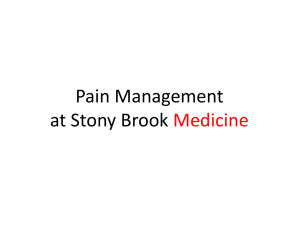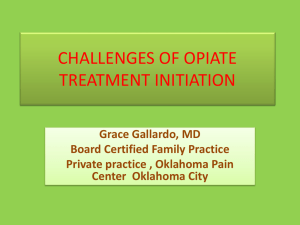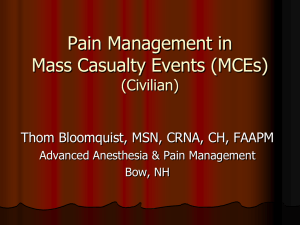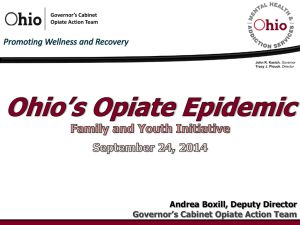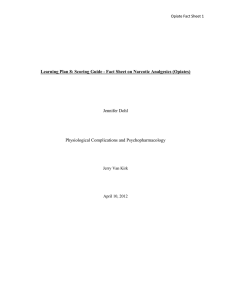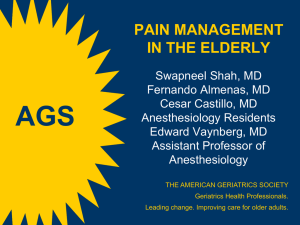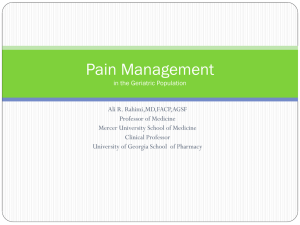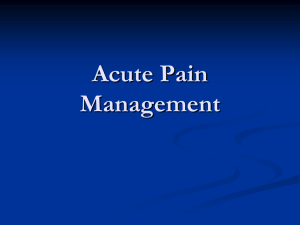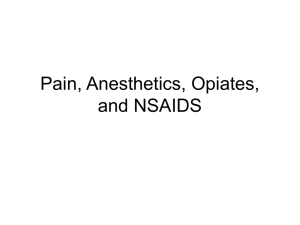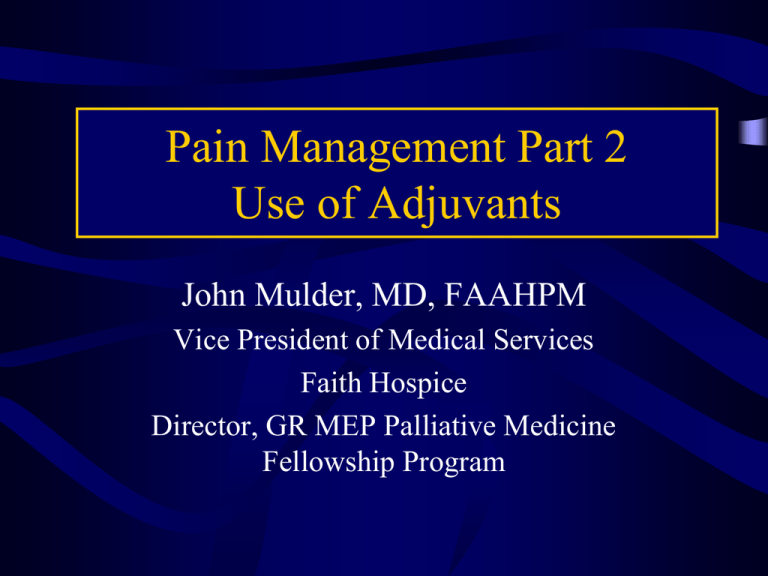
Pain Management Part 2
Use of Adjuvants
John Mulder, MD, FAAHPM
Vice President of Medical Services
Faith Hospice
Director, GR MEP Palliative Medicine
Fellowship Program
Coanalgesic Drugs (Adjuvant Therapy)
Definition: Drugs which enhance analgesic
efficacy of opioids, treat concurrent symptoms
that exacerbate pain, or produce independent
analgesia for specific types of pain.
• Early use optimizes comfort and function by
preventing or reducing side effects of higher
doses of opioids
Coanalgesic Drugs (Adjuvant Therapy)
Most
•
•
•
Most
•
•
•
•
amenable cancer pain syndromes
Bone metastases
Neuropathic pain
Visceral distention
commonly used coanalgesic drugs
NSAIDs
Corticosteroids
Antidepressants
Anticonvulsants
Bone Metastases - Adjuvants
• NSAIDs
• Steroids
• Decadron 4mg BID, titrate
• Bisphosphonates
• Zometa, Aredia
• Radioisotopes
Neuropatic Pain – Adjuvants
• Tricyclic antidepressants
• Anticonvulsants
• Steroids
Alternative/Adjuvant Medications
• NSAIDs
• Antidepressants
• TCA - Elavil, gold standard; desipramine
• SSRI - Paxil only one shown
effective thus far; Serzone, Effexor
promising
• Psychostimulants - dietary caffeine, Ritalin,
amphetamines
Alternative/Adjuvant Medications
• Neuroleptics
• Benzodiazapines (watch for sedation)
• Anticonvulsants - especially for neurogenic
pain (Neurontin)
• Baclofen
Alternative/Adjuvant Medications
• Steroids - high dose, short term/low-dose,
long term
• Antihistamines (Benedryl, Vistaril)
• Alpha-2-adrenergic stimulants (Clonidine)
• Cannabanoids
Alternative/Adjuvant Medications
• Capsaicin
• Colchicine
• Thalidomide
• Ketamine
• Lidocaine
• Dextromethorphan - (no guaifenesin or
alcohol) - 30 mg BID - 1 g/d (400 - 600 mg/d
usual )
Narcotic Resistant Pains
• Headaches
• Muscle Spasm
• Tenesmoid (Bowel / Bladder)
• Incident to movement
• Decubitus
• Deafferentation
Deafferention Pain
• Type I Complex Regional Pain Syndrome
A syndrome characterized by severe burning pain in an extremity
accompanied by sudomotor, vasomotor, and trophic changes in
bone without an associated specific nerve injury. ...
• Complex Regional Pain Syndromes
Conditions characterized by pain involving an extremity or other
body region, HYPERESTHESIA, and localized autonomic
dysfunction following injury to soft tissue or nerve. The pain ...
• Reflex Sympathetic Dystrophy Syndrome
A syndrome characterized by severe burning pain in an extremity
accompanied by sudomotor, vasomotor, and trophic changes in
bone without an associated specific nerve injury. ...
Non-pharmacologic Interventions
• OMM
• Acupuncture
• Acupressure
• Massage Therapy
• Music Therapy
• Hypnosis
• Relaxation
Unwarranted / Exaggerated Fears
• Respiratory Depression
• Addiction
• Rapid Tolerance
• Regulatory Reprisal
Opiate Side Effects: Constipation
– Most common side effect - expected
– Mediated spinally and in GI tract
– Decreased peristalsis & decreased intestinal
secretions
– Tolerance does not readily occur
– Treat with peristaltic agent and softeners prophylactically
Opiate Side Effects: Pruritis
–
–
–
–
Caused by opioid induced histamine release
Tolerance generally develops quickly
Difficult cases may require a change in opioid
Usually treated with transient use of
antihistamines
Opiate Side Effects: Somnolence / Sedation
– Common, but tolerance typically develops within
a few days
– Sedation varies with opioid and dosing schedule
– Additive effects with other cerebral depressants
– Decrease or discontinue other cerebral depressants
– Concurrent use of Dextroamphetamine or
Methylphenidate is helpful, but tachyphylaxis is
common
Opiate Side Effects: Hallucinations /
Confusion
– Less common, but may occur especially in
older patients
– Often an indication of excess dosing
– Try dose reduction or different opioid
Opiate Side Effects: Nausea / Vomiting
– Occurs in 50 – 65% of patients on oral
morphine
– Varies with drug and route
– Usually easy to control, occasionally severe and
difficult to control
Opiate Side Effects: Urinary Retention
– Opioids increase smooth muscle tone
(sphincter)
– May also cause bladder spasms
– Try changing opioids or insertion of catheter
Opiate Side Effects: Myoclonus
– Can occur with all opioids
– Typically due to high doses and/or dehydration
– Long half-life metabolites are typically
implicated
– Reduce dose, change opioids, change routes
and/or hydrate patient
Opiate Side Effects: Respiratory Depression
– Cause of death in opioid overdose
– Tolerance develops rapidly
– Rarely a concern with appropriate dose
escalations
– If accidental overdose occurs in a patient
chronically receiving opioids, dilute Naloxone
1:10 and titrate very carefully to reverse
respiratory depression without precipitating
withdrawal or reversing analgesia



